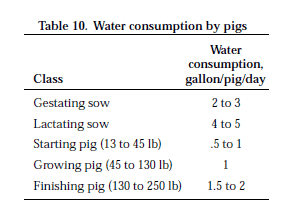Swine Nutrition Guide: Water
Water -- Water is one of the most important components of a feeding program for swine. Vital to all body functions, water accounts for as much as 80% of body weight in pigs at birth and declines to about 50% in market swine.
How much water does a pig consume?
Refer to Table 10 for estimated water needs of various classes of swine. In general, a pig will consume 1/4 to 1/3 gallon of water for every pound of dry feed. The water requirements are variable, with the need for water increasing when a pig has diarrhea or experiences warm or hot environmental conditions. Diets high in salt or protein or other ingredients whose byproducts of digestion and metabolism are excreted via the kidney also increase water needs.

Lactating sows must have unlimited access to water if they are to produce milk adequately. Suckling pigs older than 10 to 14 days of age need water in addition to that in milk for optimum performance.
With typical nipple drinking devices, the rate of delivery (cups/ minute) has little effect on performance as long as a minimal delivery rate is achieved with the device. Pigs generally make up for reduced delivery rates by spending more time at the drinking device.
Suggested minimum delivery rates for nipple drinking devices are:
- starting pigs — 1 to 1.5 cups/ minute
- growing-finishing pigs — 2 to 3 cups/minute
- sows and boars — 3 to 4 cups/minute
For all classes of swine that are housed in pens, we recommend that at least one nipple drinker device be provided for every 15 pigs in the social group, with a minimum of 2 devices per group. We recommend one nipple drinker device for every 10 pigs in the nursery.
Recent research suggests that if water waste is a concern, the use of wet/dry feeders or bowl drinkers may result in which the nipple drinker is incorporated in the feed bowl of the feeder as the sole source of water may result in up to a 40% reduction in slurry volume. Newer designs of drinking devices may also reduce water wastage when compared to traditional nipple drinking devices. Consideration of the need for wasted water for proper functioning of manure transfer and storage devices is a consideration in drinker device selection.
What about water quality?
Water that meets standards for human consumption is ideal. Most problems with water quality are related to bacterial contamination, either in the well or water delivery system. A laboratory result equal to or less than 1 coliform per 100 mL is considered acceptable for all classes of swine. Levels higher than 5 bacteria forming colonies per 100 mL are cause for immediate concern and remedial action.
Water containing elevated levels of sulfates (so called stinky water) will cause a slight to moderate diarrhea with a characteristic black color in the feces. Water containing up to 3,000 ppm sulfate or 5,000 ppm total dissolved solids (TDS) can be consumed safely by swine after a period of adaptation.
Many laboratories report electrical conductivity as an estimator of TDS. Although the constant in the formula varies somewhat depending on the sulfate content of the water in question, a general estimate of TDS is:
TDS = K/.75
where:
TDS = Total Dissolved Solids in ppm
K = electrical conductivity in microomhmos
.75 = constant
Water containing up to 100 ppm NO3-N (nitrate-nitrogen) or 440 ppm NO3 (nitrate) is considered safe for all classes of swine. Recent research results suggest that water containing up to 450 ppm NO3-N or 1,980 ppm NO3 will not cause adverse reactions in growing-finishing pigs.
Water normally contains minerals that are added to swine diets (e.g. calcium or sodium). However, minerals from a water source should not substitute for quantities recommended in the feed.
Do you recommend using water sweeteners or water acidifiers?
No. Water sweeteners and acidifiers have been ineffective in routinely enhancing water intake and improving the performance of starting pigs.
This article hasn't been commented yet.


Write a comment
* = required field